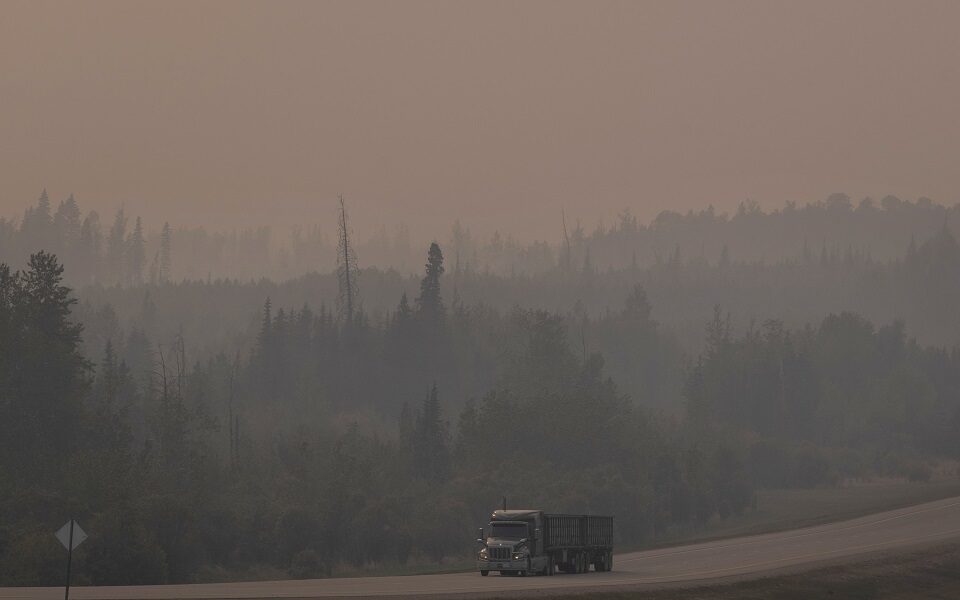One thing most countries have in common: Unsafe air

Only 10 countries and territories out of 134 achieved the World Health Organization’s standards for a pervasive form of air pollution last year, according to air quality data compiled by IQAir, a Swiss company.
The pollution studied is called fine particulate matter, or PM2.5, because it refers to solid particles less than 2.5 micrometers in size: small enough to enter the bloodstream. PM2.5 is the deadliest form of air pollution, leading to millions of premature deaths each year.
“Air pollution and climate change both have the same culprit, which is fossil fuels,” said Glory Dolphin Hammes, the CEO of IQAir’s North American division.
The World Health Organization sets a guideline that people shouldn’t breathe more than 5 micrograms of fine particulate matter per cubic meter of air, on average, throughout a year. The US Environmental Protection Agency recently proposed tightening its standard from 12 to 9 micrograms per cubic meter.
The few oases of clean air that meet World Health Organization guidelines are mostly islands, as well as Australia and the northern European countries of Finland and Estonia. Of the non-achievers, where the vast majority of the human population lives, the countries with the worst air quality were mostly in Asia and Africa.
Where some of the dirtiest air is found
The four most polluted countries in IQAir’s ranking for 2023 – Bangladesh, Pakistan, India and Tajikistan – are in South and Central Asia.
Air quality sensors in almost one-third of the region’s cities reported concentrations of fine particulate matter that were more than 10 times the WHO guideline. This was a proportion “vastly exceeding any other region,” the report’s authors wrote.
The researchers pointed to vehicle traffic, coal and industrial emissions, particularly from brick kilns, as major sources of the region’s pollution. Farmers seasonally burning their crop waste contribute to the problem, as do households burning wood and dung for heat and cooking.
China reversed recent gains
One notable change in 2023 was a 6.3% increase in China’s air pollution compared with 2022, after at least five years of improvement. Beijing experienced a 14% increase in PM2.5 pollution last year.
The national government announced a “war against pollution” in 2014 and had been making progress ever since. But the sharpest decline in China’s PM2.5 pollution happened in 2020, when the coronavirus pandemic forced much of the country’s economic activity to slow or shut down. Dolphin Hammes attributed last year’s uptick to a reopening economy.
And challenges remain: 11 cities in China reported air pollution levels last year that exceeded the WHO guidelines by 10 times or more. The worst was Hotan, Xinjiang.
Significant gaps in the data
IQAir researchers analyze data from more than 30,000 air quality monitoring stations and sensors across 134 countries, territories and disputed regions. Some of these monitoring stations are run by government agencies, while others are overseen by nonprofit organizations, schools, private companies and citizen scientists.
There are large gaps in ground-level air quality monitoring in Africa and the Middle East, including in regions where satellite data show some of the highest levels of air pollution on Earth.
As IQAir works to add data from more cities and countries in future years, “the worst might be yet to come in terms of what we’re measuring,” Dolphin Hammes said.
Wildfire smoke: a growing problem
Although North America is one of the cleaner regions in the world, in 2023 wildfires burned 4% of Canada’s forests, an area about half the size of Germany, and significantly impaired air quality.
Usually, North America’s list of most polluted cities is dominated by the United States. But last year, the top 13 spots all went to Canadian cities, many of them in Alberta.
In the United States, cities in the Upper Midwest and the mid-Atlantic states also got significant amounts of PM2.5 pollution from wildfire smoke that drifted across the border.
Risks of short-term exposure
It’s not just chronic exposure to air pollution that harms people’s health.
For vulnerable people like the very young and old, or those with underlying illnesses, breathing in large amounts of fine particulate pollution for just a few hours or days can sometimes be deadly. About 1 million premature deaths per year can be attributed to short-term PM2.5 exposure, according to a recent global study published in The Lancet Planetary Health.
The problem is worst in East and South Asia, as well as in West Africa.
Without accounting for short-term exposures, “we might be underestimating the mortality burden from air pollution,” said Yuming Guo, a professor at Monash University in Melbourne, Australia and one of the study’s authors.
US disparities widen
Within individual countries, air pollution and its health effects aren’t evenly distributed.
Air quality in the United States has generally been improving since the Clean Air Act of the 1970s. Last decade, premature deaths from PM2.5 exposure declined to about 49,400 in 2019, down from about 69,000 in 2010.
But progress has happened faster in some communities than in others. Racial and ethnic disparities in air pollution deaths have grown in recent years, according to a national study published this month.
The census tracts in the United States with the fewest white residents have about 32% higher rates of PM2.5-related deaths, compared with those with the most white residents. This disparity in deaths per capita has increased by 16% between 2010-19.
The study examined race and ethnicity separately, and found the disparity between the census tracts with the most and least Hispanic residents grew even more, by 40%.
In IQAir’s rankings, the United States is doing much better than most other countries. But studies that dig deeper show air quality is still an issue, said Gaige Kerr, a research scientist at George Washington University and the lead author of the disparities paper published in the journal Environmental Health Perspectives. “There’s still a lot of work to do,” he said.
Kerr’s research showed that mortality rates were highest on the Gulf Coast and in the Ohio River Valley, in areas dominated by petrochemical and manufacturing industries. He also noted that researchers have seen a slight uptick in rates of PM2.5-related deaths starting around 2016, particularly in the Western states, likely because of increasing wildfires.
This article originally appeared in The New York Times.






